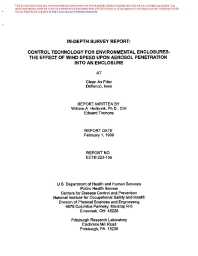Mining Publication: In-depth Survey Report: Control Technology for Environmental Enclosures - The Effect of Wind Speed Upon Aerosol Penetration Into an Enclosure at Clean Air Filter, Defiance, IA
Original creation date: February 1999
The effect of wind speed upon aerosol penetration into an idealized enclosure was studied. The idealized enclosure was a painted plywood box that was 1.2X1.2 X1 meters in volume. Two fans supplied 1.7 (cum)/min of filtered air to this enclosure at a static pressure of 2.8 mm of water. The enclosure had a 7.5 cm diameter vent port which was isolated from the air flow around the enclosure. To simulate holes in real enclosures, three 1.6-cm diameter holes were drilled on the front and back sides of the enclosure. This simulated enclosure was placed in a tunnel-like structure. The air flow from an ultra-light aircraft was directed at the front of the enclosure. The air speeds were varied between 14 and 26 km/hr as measured by rotating vane anemometer. Static pressure in the enclosure was measured with an electronic manometer. Two optical particle counters measured the particle number concentration of particles between the 0.35 to 0.5 um inside and outside of the enclosure. Aerosol penetration into the enclosure was computed as the ratio of the aerosol concentration inside the enclosure to the concentration outside of the enclosure. Aerosol penetration into the enclosure was computed as the ratio of the aerosol concentrations inside the enclosure to the concentration outside of the enclose. The enclosure static pressures measured increase form 2.8 to 3.4 mm of water (P=0.0001). Aerosol penetration into the enclosure increased linearly with air velocity about the simulated enclose. When simple linear regression was used to model the observed penetration as a function of the estimated penetration, the value of the slope was 0.69 +/- 0.12 and the P value for the regression model was less than 0.0001. These results indicate that enclosure static pressure needs to be higher than the wind's velocity pressure in order to minimize aerosol penetration into these enclosures.
Authors: WA Heitbrink, ED Thimons
Reference - February 1999
NIOSHTIC2 Number: 20000559
Cincinnati, OH: U.S. Department of Health and Human Services, Public Health Service, Centers for Disease Control and Prevention, NIOSH, Report No. ECTB 223-15a, 1999 Feb; 24 pp
See Also
- Characterizing Exposures to Airborne Metals and Nanoparticle Emissions in a Refinery
- Comparing Measurements of Carbon in Diesel Exhaust Aerosols Using the Aethalometer, NIOSH Method 5040, and SMPS
- Development of a Statistical-Analytical Approach for Assessing Coal Bump Potential
- Experimental and Modeling Investigation of the Effect of Ventilation on Smoke Rollback in a Mine Entry
- Explosion Pressure Design Criteria for New Seals in U.S. Coal Mines
- A Gas Pressure-Based Drift Round Blast Design Methodology
- In Situ Estimation of Roof Rock Strength using Sonic Logging
- Measurement of Airflow in a Simulated Underground Mine Environment Using an Ultrasonic Anemometer
- Reverse Performance Characteristics of Main Mine Fans
- Tying Acceleration and GPS Location Information Together To Create a Mine Management Tool
- Page last reviewed: 9/21/2012
- Page last updated: 9/21/2012
- Content source: National Institute for Occupational Safety and Health, Mining Program


 ShareCompartir
ShareCompartir
